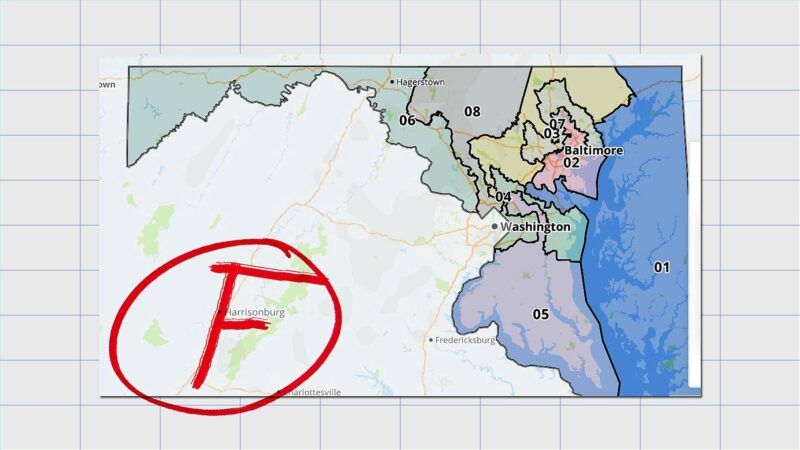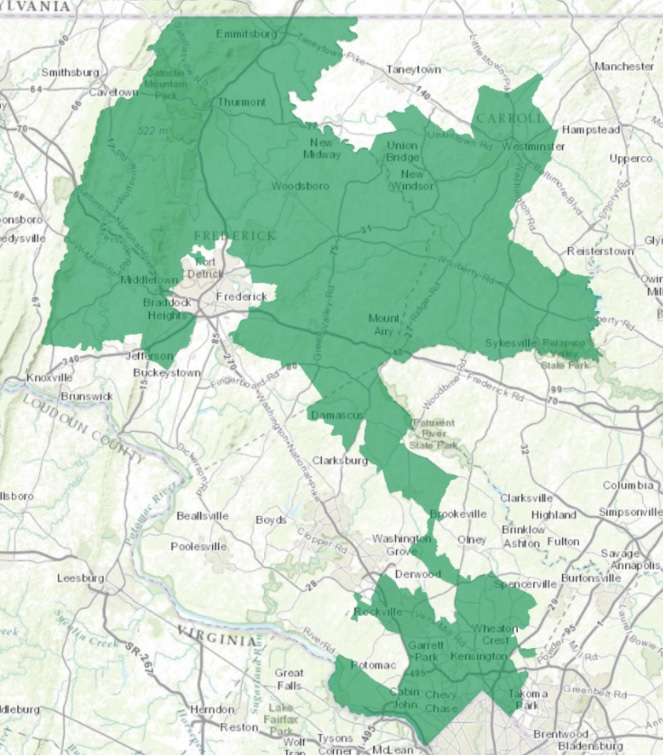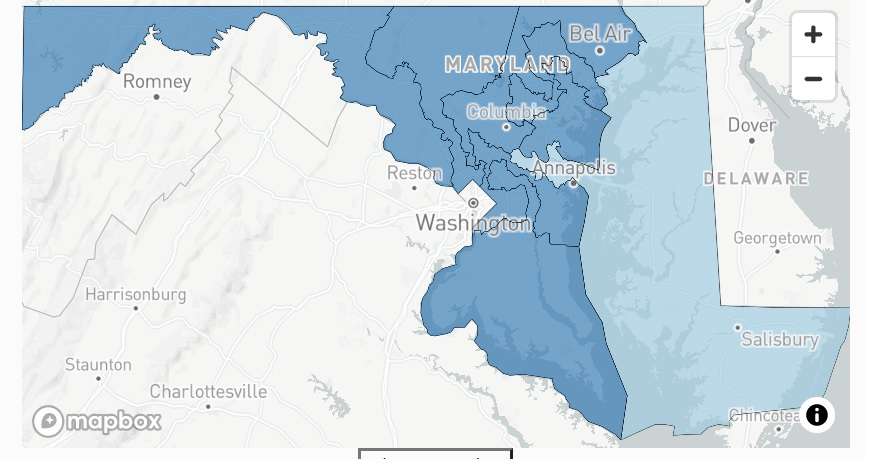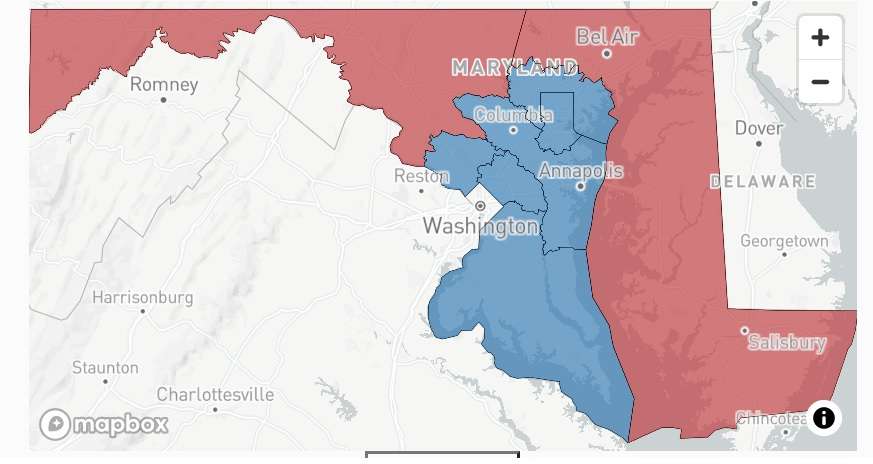Maryland Democrats Hate Gerrymandering So Much, They're Trying To Eliminate the State's Lone Republican District
When it comes to drawing congressional districts, concerns about the legitimacy of democracy seemingly go out the window.

Rep. Jamie Raskin (D–Md.) has some thoughts about gerrymandering.
When the U.S. Supreme Court reviewed Wisconsin's congressional district map in 2017, Raskin was one of several members of Congress to submit an amicus brief calling on the court to "end partisan gerrymandering." He's claimed on Twitter that "gerrymandering empowers political minorities to redistrict political majorities into near-oblivion," issued an official statement claiming that "Republican state legislators…have perfected the art of redistricting for the goal of destroying the political opposition," and introduced a bill in Congress that would force states to use nonpartisan panels to redraw political district lines.
For the most part, Raskin's critiques are not wrong. Bizarre and misshapen congressional districts are often the result of a partisan effort to cement certain outcomes in future elections. State lawmakers, who in most cases control the once-every-decade redistricting process, are motivated to craft maps that allow their "team" to win as many districts as possible.
That's how you end up with districts like look like—well, sort of like Raskin's own congressional district in Maryland:

In their current (soon-to-be-replaced) form, Maryland's congressional districts are some of the most gerrymandered in the entire country. The current map, approved in 2011, was rated as the least-compact set of districts in the country by mapping firm Azavea in a 2012 report. (Compactness, which can be measured in several ways, is just one method of determining whether a district is gerrymandered, and while it can be flawed in some circumstances, it is generally a useful metric.) Raskin's eighth district is actually one of the state's least-bad districts—the current third district and sixth district were two of the nine least-compact districts in America when they were drawn, according to Azavea.
All those zigzagging district lines have helped Democrats win seven of the state's eight congressional seats in each of the five elections held since the current map was adopted in 2011. Yes, Maryland is a blue state, but gerrymandering has exaggerated the Democratic edge—or, as Raskin might say, it has helped push Maryland's political minority into near-oblivion.
Now, the state's congressional map is about to get even more gerrymandered.
The Maryland Legislative Redistricting Advisory Commission voted on November 23 to give preliminary approval to one of the four maps drawn up by state lawmakers who sit on the panel. The recommended map would give Democrats an electoral advantage in all eight of the state's districts by carving up Maryland's deep blue Baltimore/Washington corridor so that nearly all of the state's congressional districts include some part of it.

The proposed map gets an F from the Princeton Gerrymandering Project, which grades congressional maps on partisan fairness, geographical compactness, and other factors. The Maryland map gets a failing grade for both its obvious lack of compactness and for the resulting political favoritism.
A fairer map, the group says, would give Democrats an edge in five or six districts.
Actually, such a map was proposed by the Maryland Citizens Redistricting Commission, a group that included three Republicans, three Democrats, and three unaffiliated Marylanders. The commission's map is like night and day when compared to the one that state lawmakers have recommended: The districts make geographic sense, and the parts of Maryland with more Republicans (the Eastern Shore and the western panhandle) are placed in districts more likely to reflect their local politics. The Princeton Gerrymandering Project gave the commission's map an A grade.

Maryland Gov. Larry Hogan, a Republican, says he would veto a congressional map that differs significantly from what the citizens commission drew up, but Democrats have large enough majorities in Annapolis to override his objection.
What's happening in Maryland is obviously not unique. The Princeton Gerrymandering Project has recently handed out F grades to proposed new congressional maps in Illinois (drawn by Democrats) and in North Carolina (drawn by Republicans). In both cases, and in plenty of other states, redistricting is proceeding the way it pretty much always does: Ideals like fairness and respect for democratic values are getting pushed aside for nakedly partisan power grabs.
Still, Maryland's highly gerrymandered proposed map offers at least three lessons about the high-stakes fights over America's congressional maps.
First, it means it is well past time to abandon the ridiculous claim that only Republicans engage in gerrymandering—a claim that's been advanced not only by Democrats like Raskin but even by The New York Times recently. Republicans engaged in some of the most egregious gerrymandering during the 2011 redistricting process, but that was mostly a function of their outsized control of state capitals at the time.
It's true that Democratic gerrymanders are a bit harder to pull off since the party's current political coalition tends to be concentrated in cities and thus easy targets for "packing" into deep blue vote sinks. But Maryland's state lawmakers are demonstrating that it's certainly possible.
Second, Maryland's redistricting process this year also suggests that removing state lawmakers from the equation might help, at least a bit. Supposedly nonpartisan redistricting commissions have had a mixed track record in the past, and there's probably no way to take politics fully out of the process. But this redistricting cycle will provide, for the first time, a significant sample size of states that have implemented various reforms. The results will be a guide for the future.
In Maryland, at least, it is undeniable that the commission-drawn map is superior to the one proposed by state lawmakers. Since legislators have the final say, however, that fact may not matter.
Finally, Maryland's messy map demonstrates how expressions of concern about the state of American democracy are sometimes nothing more than cynical, partisan ploys. Republican attacks on the foundations of the democratic process are a serious concern, of course, but partisan gerrymandering undermines the legitimacy of elections too—by allowing candidates to pick their voters rather than the other, proper, way around.
That also means fewer competitive elections and a political landscape that favors the fringes of both major parties. "If current maps are a harbinger of the rest of the redistricting cycle, the 2022 midterms will feature far fewer competitive districts," writes Michael Li, a senior counsel for the Brennan Center for Justice, a public policy nonprofit housed at New York University's law school. We should not ignore those harms just because gerrymandering is more routine and expected.
Remember Raskin, the supposed gerrymandering-reformer who hails from a district that is itself deeply gerrymandered? Surely, he must be a sharp critic of the outlandishly partisan proposal Maryland Democrats are pushing in Annapolis.
"Raskin's press secretary, Jacob Wilson, said the congressman is not currently commenting on the redistricting process," Bethesda Magazine reported last month.
So much for that.


Show Comments (163)